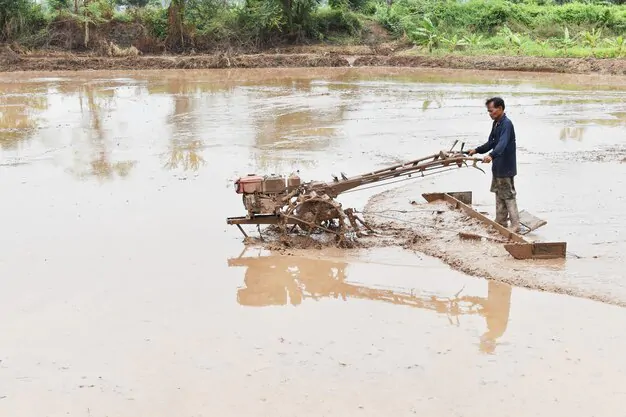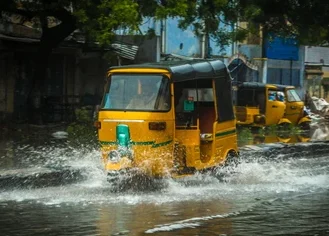Last Updated on July 22, 2024 7:49 pm
What problems can monsoons cause in India?

You open the door and step outside into torrential rain. The streets have flooded, swallowing the sidewalks and spilling into buildings. This is the new monsoon season in India. For months, relentless downpours have inundated the subcontinent, bringing catastrophic damage to infrastructure, agriculture, and public health. Each day the rains continue, the situation grows more dire. Roads crumble, crops spoil, and waterborne diseases spread. Your commute becomes life-threatening. Grocery stores stand empty. Hospitals overflow with patients. This is the new monsoon season in India, and it is a disaster. In this article, we will explore the wide-ranging impacts of excessive monsoon rains and what can be done to mitigate the effects of this dangerous weather pattern.
Overview of the Monsoon Season in India
The monsoon season in India is a highly anticipated annual phenomenon, marked by the arrival of heavy rainfall and a dramatic shift in weather patterns. This seasonal change typically begins in early June and continues through October, transforming the arid landscapes into a lush, verdant paradise.
The Indian monsoon is part of the larger Asian monsoon system, a meteorological marvel driven by the temperature differential between land and ocean. As the summer months approach, the intense heating of the Indian subcontinent creates low-pressure zones, drawing in moisture-laden winds from the Indian Ocean and the Arabian Sea. While the monsoon affects the entire nation, its intensity and duration vary across different regions. The southwestern coastal areas, such as Kerala and Karnataka, are among the first to experience the monsoon rains, often as early as late May or early June. As the season progresses, the rains gradually advance northward, engulfing the central and northern parts of the country.
The monsoon rains are a life-giving force for India’s primarily agrarian economy, replenishing water sources and nourishing the soil for crop cultivation. However, excessive or erratic rainfall can also lead to devastating floods, landslides, and crop damage, underscoring the delicate balance required for a successful monsoon season.
In recent years, advancements in meteorological technology and forecasting models have improved the ability to predict the onset, intensity, and distribution of the monsoon rains. Accurate forecasting plays a crucial role in mitigating potential risks and optimizing agricultural planning, water management, and disaster preparedness efforts.
Beyond its meteorological and economic significance, the monsoon season holds deep cultural and spiritual resonance in India. Numerous festivals and traditions are intricately woven into this annual cycle, celebrating the rejuvenation of nature and the abundance it brings.
Excessive Rains Cause Widespread Flooding and Water Logging

Intense monsoon rainfall can rapidly overwhelm drainage systems, leading to severe flooding and waterlogging across vast areas. This disrupts daily life, damages property and infrastructure, and poses serious health risks. Heavy, persistent rains can wipe out entire crop yields over wide agricultural regions. Excess surface water saturates and erodes fertile topsoil, stripping it of vital nutrients. Flooded fields prevent necessary activities like planting, weeding, and harvesting – jeopardizing food security. Flooding wreaks havoc on roads, bridges, buildings, and other critical infrastructure. Waterlogged areas see increased soil erosion around the foundations of structures. This erosion compromises structural integrity, potentially causing collapse. Floodwaters also corrode metals and deteriorate concrete over time.
Severe flooding allows runoff to carry pollutants into water sources like rivers and groundwater reservoirs. Overflowing sewers and septic systems contaminate supplies with hazardous bacteria and chemicals. This toxic runoff poses grave risks to public health and local ecosystems.
Stagnant flood waters become breeding grounds for disease vectors like mosquitoes that spread malaria, dengue fever, and other illnesses. Waterborne pathogens in the pooled water can also cause outbreaks of cholera, hepatitis, and diarrheal diseases – especially among vulnerable groups.
The devastation from excessive rains highlights India’s pressing need for improved flood prevention, drainage infrastructure, and disaster response capabilities. Enhancing resilience will be crucial to protect lives, sustain agriculture, and shield the economy from these recurring calamities.
Damage to Roads, Buildings, and Other Infrastructure

The ferocious monsoon rains unleash havoc on India’s road networks every year. Incessant downpours erode and wash away vital road links, creating deep potholes and crevices. Highways crumble under the relentless onslaught, slowing traffic to a crawl and endangering motorists. Weakened by waterlogging, road surfaces become treacherous deathtraps, leading to numerous accidents.
Excessive rainfall doesn’t spare residential and commercial structures either. Low-lying areas face the brunt as rainwater accumulates, seeping into foundations and compromising structural integrity. Poorly constructed buildings, often hastily erected without proper planning, are particularly vulnerable – their walls collapse like houses of cards, leaving families devastated. Even robust concrete edifices suffer cracks and fissures from the unrelenting moisture assault.
India’s civic infrastructure buckles under the monsoon’s might. Drainage systems, ill-equipped to handle the deluge, overflow and flood streets. Crucial utilities like power and telecommunications face frequent outages as lines are downed by falling trees or submerged by rising waters. Tragically, loss of these vital services exacerbates the plight of those stranded in submerged areas, compounding an already dire humanitarian crisis.
The catastrophic effects of heavy rains underscore the pressing need for climate-resilient infrastructure planning in India. Incorporating updated rainfall data, flood mapping, and robust drainage systems in urban design is crucial. Stringent construction codes mandating weather-resistant materials and elevated foundations in flood-prone zones could mitigate future losses. Only through proactive measures can the nation fortify itself against the intensifying monsoon onslaught.
Increased Soil Erosion
The relentless rains have also accelerated soil erosion across farmlands. Torrential waters wash away nutrient-rich topsoil, reducing soil fertility. This erosion makes it increasingly difficult for crops to establish strong root systems and access essential minerals for growth.
Soil runoff carries agricultural non-point source (NPS) pollutants like fertilizers, pesticides, and animal waste into nearby streams and rivers. This contamination disrupts aquatic ecosystems and poses health risks to local communities relying on these water sources.
Green Mold and Algal Blooms

Waterlogged conditions create the perfect breeding ground for green molds and algal blooms to thrive. These organisms can quickly infest crops, causing widespread rot and contamination. These Green molds are extremely slippery and walking on these requires a lot of attention beacuse slip-and-fall accidents are an unfortunate reality, especially on road surfaces where mold, algae, and other organic growths have been allowed to proliferate. The buildup of slimy green mold on sidewalks and walkways creates a serious hazard, leaving pedestrians at risk of injury from twisted ankles, broken wrists, and head trauma from impact.
Algal blooms in water bodies deplete oxygen levels, suffocating aquatic life and rendering the water unsafe for irrigation or drinking. Addressing these environmental hazards requires costly remediation efforts, further straining agricultural communities already grappling with crop losses.
The excessive monsoon rains have dealt a severe blow to India’s agricultural productivity. Implementing sustainable farming practices, improving drainage systems, and developing drought/flood-resistant crop varieties are crucial steps to mitigating future losses from extreme weather events.
Increase in Insects, Pests, and Water-Borne Diseases
Excessive monsoon rains create the ideal breeding grounds for mosquitoes and other disease vectors. Stagnant water pools formed by flooding provide ample nurseries for mosquito larvae to thrive. Moreover, the warm, humid conditions during monsoon season offer an optimal climate for adult mosquitoes to multiply rapidly.
As a result, cases of mosquito-borne illnesses like malaria, dengue fever, chikungunya, and Zika virus tend to surge during and immediately following the monsoon period. Weakened municipal infrastructure and overwhelmed health services further compound the public health crisis.
Heavy, persistent rains also create problems for agriculture beyond just delaying crop cycles. Waterlogged fields become breeding pools for insects and pests that can decimate crops. Fungi, bacteria, and viruses find ideal conditions to propagate in the soggy environments.
Farmers may face infestations of locusts, armyworms, whiteflies, and other destructive pests that swarm the fields. Diseases affecting grains, fruits, and vegetables become more prevalent. This double whammy of delayed harvests and pest/disease damage severely impacts food production and supply chains.
Intense monsoon downpours frequently lead to the failure of water treatment and sewage systems. Backed-up drains and burst pipes allow untreated wastewater to mix with clean water sources, contaminating them with harmful pathogens.
People exposed to this polluted water risk contracting water-borne diseases like cholera, typhoid fever, hepatitis A, diarrhea, dysentery, and gastroenteritis. Children are especially vulnerable. Prompt repairs, improved sanitation infrastructure, and education on safe water practices become crucial during these periods.
Loss of Vegetation and Changes to Ecosystems

Excessive monsoon rains put immense stress on India’s diverse vegetation and ecosystems. Prolonged flooding can damage or destroy plant life, altering the delicate balance of local habitats. Many species rely on specific vegetation for food and shelter. As plant life diminishes, animals are forced to adapt or relocate – often with devastating consequences for population numbers.
Climate change is exacerbating the intensity of India’s monsoons. This disrupts natural biodiversity as certain species struggle to cope with the changing conditions. Some flora and fauna may not survive the onslaught of heavy rains and flooding. Others could see population booms as they temporarily thrive in the wetter conditions. However, such imbalances are unsustainable long-term.
India’s coastal mangrove forests play a vital role in mitigating monsoon impacts. Their intricate root systems act as a natural buffer, absorbing floodwaters and preventing soil erosion. Mangroves also provide a sheltered habitat for marine life. However, mangroves face threats from deforestation and degradation – reducing this key environmental defense against extreme rainfall.
Healthy, biodiverse ecosystems are more resilient to environmental stresses like excessive monsoons. A wide variety of plant and animal species can better adapt to changing conditions. In contrast, areas with low biodiversity are more vulnerable to devastation. Preserving India’s rich ecosystems is crucial for withstanding intensifying monsoon effects driven by climate change.
Economic Impacts and Strain on Public Health Services
Excessive monsoons and flooding impose immense economic costs on India. The country loses billions annually due to damaged infrastructure, agricultural losses, and strain on public services. Rebuilding after floods diverts funds from other priorities like healthcare and education. This strain on public finances leaves less for critical investments in economic development.
Successful monsoons boost farm production and incomes, benefiting millions of agricultural workers and farmers. However, excessive rains lead to crop losses, reduced yields, and soil degradation. This reduces farm incomes and negatively impacts processing output, trade, and agricultural supply chains. Lower rural incomes strain public health services as poverty worsens nutrition, sanitation, and access to care. Flooding causes injuries, disease outbreaks like cholera, and mental health issues like post-traumatic stress disorder (PTSD). Lower-income communities face greater risks from lack of clean water, inadequate shelter, and poor sanitation. Strained public health services struggle to meet surging demand for emergency care, disease treatment, and mental health support. Economic losses compound as illness disrupts work and productivity. Severe flooding forces many to flee their homes, often to crowded shelters lacking adequate food, water and sanitation. This displacement disrupts livelihoods, education, and access to healthcare. Some migrate away from flood-prone areas, straining urban infrastructure and public services. The resulting poverty concentrates health risks in cities ill-equipped to handle the influx.
By understanding these complex economic impacts and public health strains, policymakers can better allocate resources, target aid, and implement disaster preparedness to build resilience against excessive monsoons.
Tips for Staying Safe During the Monsoon Season
The annual monsoon season brings heavy rainfall that can lead to dangerous flooding, disruptions to infrastructure and utilities, and potential health hazards. Taking proper precautions is essential for staying safe. Here are some key tips:
Prepare Your Home
- Inspect your home for any cracks, leaks or areas where water could enter and seal them properly.
- Clear drainage systems like gutters and downspouts to allow proper water flow.
- Stock up on emergency supplies like non-perishable food, clean water, medicine, and batteries.
Stay Informed
- Monitor weather reports and official updates on potential flooding or storms. Heed all warnings.
- Identify safe evacuation routes and nearby shelters in case you need to leave quickly.
- Learn how to safely turn off utilities like electricity, gas and water if instructed.
Exercise Caution Outdoors
- Avoid areas prone to flooding like low-lying grounds, valleys or underground spaces.
- Never attempt to walk, swim or drive through flood waters which can be deceptively powerful.
- If outside, find a sturdy shelter and avoid trees or structures that could collapse.
Watch for Health Risks
- Floodwaters can contain sewage, chemicals and debris posing serious health hazards. Avoid contact.
- Drink only boiled or bottled water until water sources are deemed safe again.
- Be alert for potential water-borne diseases and seek medical care if experiencing symptoms.
Have an Emergency Plan
- Discuss and practice an emergency plan with your family for communication and regrouping.
- Keep emergency contacts and crucial documents in a waterproof pouch or backed up digitally.
- Ensure you have adequate supplies of any essential medications on hand.
By taking proactive measures and remaining vigilant, you can help protect your household during the hazardous monsoon period. Prioritize safety above all else.
FAQs on Excessive Monsoons in India: Effects of Green Molds and Algae Formation
Common Fungal Growths
During excessive rainfall, damp conditions can promote the rapid growth of various fungi and microorganisms. Two common culprits are green molds and algae blooms.
Green molds thrive in humid, moisture-rich environments. They can quickly spread across surfaces, walls, and even inside buildings. Prolonged exposure to these molds can trigger allergic reactions, respiratory issues, and exacerbate conditions like asthma.
Toxic Algae Blooms
Heavy monsoon rains can also lead to an overgrowth of algae in water bodies. This is known as an algal bloom. While not all algae are harmful, certain types produce toxic compounds that can contaminate drinking water supplies and harm aquatic life.
Blue-green algae (cyanobacteria) are particularly concerning. Their toxins can cause rashes, stomach issues, and even liver damage in severe cases when ingested through contaminated water sources.
Preventive Measures
To minimize health risks, it’s crucial to:
- Quickly dry out damp areas to prevent mold growth
- Use dehumidifiers and improve ventilation indoors
- Avoid direct contact with stagnant water during/after floods
- Boil or treat water from untrusted sources before consumption
Local authorities should also regularly monitor water quality and issue advisories about potential algae blooms.
Long-Term Impacts
Unchecked growth of green molds can weaken and damage building structures over time. Toxic algae can disrupt entire aquatic ecosystems, affecting fisheries and biodiversity.
Addressing excessive monsoon rainfall, improving drainage systems, and promoting sustainable environmental practices are vital to mitigating these hazardous effects in the long run.
Conclusion
Ultimately, the excessive monsoons in India pose serious risks that require coordinated efforts across infrastructure, agriculture, and public health sectors. As you have seen, flooding and landslides damage critical infrastructure, reduce crop yields, spread disease, and disrupt everyday life for millions. Moving forward, investing in resilient infrastructure, agricultural diversification, and preventative healthcare can help communities better cope when the heavy rains come. While monsoons are vital for India, their extremes highlight the importance of preparation and adaptation. With informed, collaborative action across sectors, India can reduce the impacts of excessive rainfall and build safer, healthier communities.


